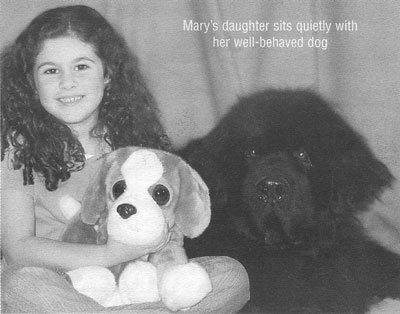

 |
 |
|
|
|
||
|
|
|
The successful raising of a companion dog is a reward in itself, especially if your family or "pack" is more than a pack of two. If you have a dog and little people in your world, it is vital to keep your pack balanced and secure to help ensure all members are happy and safe.
In order for children and dogs to interact within a pleasant and harmonious "pack" or family unit, you need to be "dog smart", provide training, and use common sense. Dogs are animals with biological needs and drives, and they think. Be sure to choose training, discipline and socializing approaches that are conducive to developing a pet with manners and respect. It is important to supervise and monitor the handling of your dog by your children and their young friends (and everybody else for that matter!) Do not hesitate to teach other children how you want your pet treated. These experiences dictate your canine's perceptions and behaviors. Learning is Never Erased, Socialize CarefullyWhether you are introducing a new puppy or dog to your pack or hoping to enhance the relationship with the canine you already have, always recognize the fact that what you allow your puppy or dog to experience with your child is what your dog is learning, and learning never ends and is never forgotten.Some puppies will handle your children and their friends without obvious problems. Others can be strongly imprinted in a negative way. Either of the following cases can promote behavior problems that can lead to puppies or dogs being unsafe when interacting with little people. If your puppy is exposed to a bully, it learns fear and may act defensively. If your puppy learns it can be pushy, it learns aggression is acceptable. Hidden Dangers of Reactive, Luring and Click & Treat TrainingMethods that employ food rewards and prompt people chasing actions for training can present some conflict of desired behavior between your pet and your child. When using these methods to teach commands such as the "Come" and "Down", trainers encourage their pet to follow a hand as it is holding a treat, and to quickly take the treat when the desired position occurs.A puppy or dog may not be able to distinguish when it should grab food from a hand and when it is not acceptable to take the food. If a canine snatches food from an unsuspecting child or person's hand a serious injury can occur. In addition, some training techniques may use actions such as running backwards, speaking in a high and excited voice, clapping hands, etc. that create a "get it" reactive chase response from the dog. This kind of training builds excitement which engages the dog's prey drive, thus creating a fast reaction. What the dog learns is that when he chases a person, he gets rewarded. The dog will look for opportunities to repeat the action - which could be an innocent jogger, a person on roller blades or children on bicycles. How is a dog going to understand the difference between training and daily interactions when manners are desired? These training methods do not teach manners and bites do happen as a result. It is not fair to dogs or those involved, especially to the children that love them. Be an inteIIigent trainer. Utilize methods that recognize that canines do think and will provide training that promotes responsible behavior, respect and manners with considerations to their environment and needs. Your children and pets are depending on you. |

|
As printed in the March 2006 issue of the Livingston Parent Journal. Mary T. Ratelle, Training Director of Results Dog Training, LLC which is celebrating twenty five years in Livingston County-2006! Her pack consists of three children and many pets. She is currently working on her first book. www.ResultsDogTraining.com. © Mary T. Ratelle 2006 - present
© copyright 2000-present Results Puppy & Dog Training and Pawformance Dog Sports! All photos, logos, and text are property of Results Puppy & Dog Training, Pawformance Dog Sports! and it's contributors. Any copying is strictly forbidden without written permission of and copy of material produced to Mary T. Ratelle.